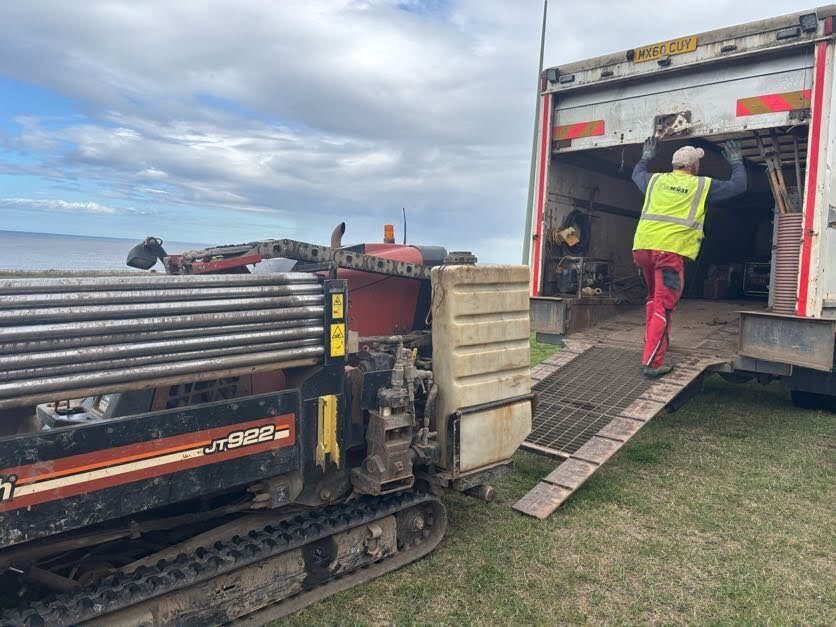Across the UK, there’s mounting pressure to upgrade underground infrastructure; lighting, power, broadband, and EV charging all require greater capacity, yet this expansion collides with an already congested network of roads, utilities, and public spaces. Digging new trenches in these environments risks traffic chaos, community disruption, and high reinstatement costs.
Yet the demand is only growing, and the rules are tightening. As local councils, highways authorities, and utility providers grapple with how to deliver essential infrastructure more sustainably and efficiently, trenchless directional drilling technology is making it possible to install underground ducting that reduces disruption, cuts cost and enables faster rollout when new demand arises.
WHAT IS DIRECTIONAL DRILLING?
Directional drilling (sometimes known as trenchless or no-dig installation) is a modern construction technique that allows underground ducts, cables, and pipes to be installed without digging long trenches or too much disruption to the surface.
Instead, a small entry and exit pit are created, and a guided drill creates a borehole underground, following a precisely controlled path. Ducts are then pulled through this borehole, neatly avoiding roads, utilities, and natural features like waterways or trees.
The result? A faster, cleaner, and safer way to deliver essential infrastructure in urban or sensitive environments.
Watch the short video below to see how directional drilling works in practice.
WHY IT MATTERS
Traditional open-cut excavation can be slow, noisy, and disruptive, often leading to costly reinstatement of roads, pavements, and landscaped areas. Directional drilling offers a smarter alternative that’s:
- Less disruptive – Keeps traffic flowing and communities connected
- Better for the environment – Protects habitats and reduces erosion
- Safer for workers and the public – No open trenches or heavy machinery
- More cost-effective – Reduces reinstatement costs and project time
- Faster – Ideal for busy urban areas where speed and precision are critical
TRADITIONAL VS. TRENCHLESS: A CLEARER PATH FORWARD
Traditional open-cut trenching has long been the standard method for installing underground services. But while effective, it comes with a long list of challenges — from heavy disruption to higher carbon and reinstatement costs.
Factor | Traditional Excavation | Directional Drilling |
Surface impact | Requires full-length trenching | Minimal disruption – small entry/exit pits only |
Environmental footprint | High – spoil removal, reinstatement, CO₂ emissions | Low – reduced waste, machinery use and reinstatement |
Speed | Slower, especially in congested or sensitive areas | Faster installation and less downtime |
Safety | Open trenches create hazards for workers and public | Enclosed system reduces risk |
Cost | Higher overall project cost due to reinstatement | Lower total cost of ownership |
Directional drilling therefore offers measurable benefits for both contractors and clients — particularly where time, access, and sustainability matter most.
INTRODUCING SUPAMOLE BY CU PHOSCO
CU Phosco’s latest innovation, Supamole, takes directional drilling to the next level.
It’s a trenchless installation system designed specifically for lighting and communications infrastructure — providing a smarter way to deliver underground connections in built-up or complex environments.
“Supamole is a smart solution for complex environments,” said Andy Kay, CU Phosco.
“It allows us to install underground ducts quickly and efficiently, without the need for open-cut trenches, heavy machinery, or major surface restoration. It’s safer, greener, and more cost-effective, especially in built-up or sensitive areas.”
WHERE DIRECTIONAL DRILLING DELIVERS RESULTS
Trenchless installation isn’t limited to one application. It’s used across the UK for:
- Street and highway lighting – avoiding disruption to roads and pavements
- EV charging networks – connecting chargers without major civil works
- Broadband and fibre rollouts – installing ducts under existing infrastructure
- Power and communications – linking new developments or public realm schemes
Supamole has been engineered with these scenarios in mind, helping local authorities and contractors complete underground works faster, cleaner, and with less disruption.
A SMARTER, CLEANER, FASTER FUTURE
Whether crossing highways, rail lines, or city streets, Supamole enables CU Phosco to deliver underground installations that are precise and efficient, even in challenging ground conditions; sustainable, by reducing waste, emissions, and environmental impact; and future-ready, supporting the rollout of smart lighting and digital networks.
Supamole represents a new direction in CU Phosco’s service portfolio — one that complements its expertise in lighting columns, smart poles, and infrastructure design, while opening new opportunities for smarter, more sustainable delivery.
